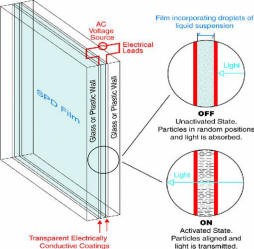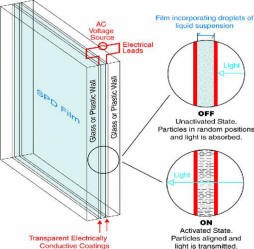
New glazing technologies are meeting and exceeding fire-rated-glass and impact-resistance code requirements, while providing expanded design options.
Most people wouldn't mention the terms "fire-rated glazing" and "exciting" in the same breath. Yet, during the past few years, the changes in fire-rated glass and framing have been so revolutionary that the building industry is beginning to catch the excitement.
Such was not always the case. Fire codes have often been viewed as design restrictive, forcing architects and builders to alter plans for the sake of fire and life safety. Yet, the code requirements themselves have proven to be a spark for innovation, resulting in new technology that has resulted in products capable of satisfying building codes without compromising design.
|
Fire-rated framing technology is matching the development pace of fire- and impact-rated glass materials. Genuine hardwood framing is available with 60-min. fire ratings and compatible with the full range of new glass options. |
One of the most sweeping code changes happened in 2003, when the International Code Council (ICC), Falls Church, VA, made a landmark revision to the International Building Code (IBC). The new code states that all glass installed in "hazardous locations," such as K-12 schools, daycare centers, and athletic facilities, must meet the impact safety standards of CPSC 16 CFR 1201. Hazardous locations include openings subject to human contact, such as doors, sidelites, and windows near the floor.
Until that code change, wired glass was standard fare in those types of buildings. It was also the standard choice when fire protection was an issue. But traditional wired glass cannot meet the CPSC impact safety standards.
Back in the late 1970s, wired glass was given a special exemption from meeting the impact safety requirement. Code officials felt wired glass should be allowed-despite its low-impact resistance-because it was the only glazing product on the market that could offer a degree of fire protection. What was originally intended to be a temporary exemption stayed in place for nearly 30 yr., resulting in the widespread use of wired glass.
Installed in so many hazardous locations, wired glass was exposed to a tremendous amount of human contact. As might be expected, a number of serious injuries resulted. The bulk of the accidents happened in schools and athletic facilities, where activity is especially high. The ICC determined that the risks of more injuries warranted revising the code to improve impact safety.
Most areas of the country have either adopted, or are in the process of adopting, the 2003 IBC change. What's more, the 2004 version of the IBC. Wherever there is a fire-rated opening in a hazardous location, glazing must satisfy the CPSC guidelines, regardless of building type. With the direction already clear, many jurisdictions enforced the 2004 IBC change ahead of schedule.
If the product offerings in fire-rated glass hadn't changed in the past 30 yr., the situation would be a crisis. Fortunately, several materials have been introduced since the days when wired glass was the only product available. Most of the newer fire-rated glazing materials far exceed the performance of traditional wired glass, in terms of both fire ratings and impact protection.
One category of materials isn't glass at all, but transparent ceramic. Long known for its ability to tolerate extremely high temperatures, ceramic has found uses in everything from kitchen cook tops to car engines. Ceramic doesn't expand and contract the way glass does, making it an extremely stable material in a fire.
Additionally, ceramic can be specified in much larger sizes than wired glass (as large as 23 sq. ft. per piece). It can withstand heat for longer periods of time, earning indoor fire ratings as long as 3 hr., and 90-min. ratings in other applications. In its laminated form, ceramic also offers high-impact safety protection, meeting CPSC 16 CFR 1201 (Category II). That's similar to tempered glass, and at least four times the impact resistance of traditional wired glass.
Another category of glazing, classified as glass fire walls, has taken an entirely different direction to achieve fire and impact resistance. While there are several variations available, these products operate on essentially the same principle in which multiple layers of glass sandwich interlayers, or a thick gel. During a fire, the interlayer/gel turns to foam, blocking heat transmission as well as the spread of fire.
Glass fire walls are such tremendous performers that they carry the same type of rating as a solid barrier wall, with listings as long as 2 hr. Even when a fire is blazing on one side of the glass, a building occupant could walk up and touch the opposite surface of the glass without being burned. This heat-blocking characteristic enables glass fire walls to be used without size restrictions, offering the design possibility of wall-to-wall and floor-to-ceiling glass.
Ironically, some of the most current innovations in the field are bringing the discussion full circle, back to wired glass. A new laminated, wired-glass product has proven strong enough to achieve higher impact ratings than traditional wired glass, thus satisfying the 2003 IBC impact requirements (CPSC 16 CFR 1201, Category I). While the newer wireless products offer a number of advantages, laminated wired glass offers a level of affordability that makes it particularly attractive. Permanently labeled and easy to cut, laminated wired glass will undoubtedly fill a void left by traditional wired glass.
What is considered a non-negotiable safety requirement in buildings today is significantly different than it was a few decades ago. Many times, architects and building owners are looking for glazing products that can do more than contain the spread of a fire. More often than not, they want a product that is "fire-rated and _________."
That blank could be filled with any variety of requirements. For example, if you're building in a high-density area where construction is close to property lines, codes may require exterior glazing that is fire-rated. However, that same glass will also need to comply with energy codes. It also may need special tinting or coatings to be consistent with other faces of the building. Such complex demands are now common, forcing fire-rated products to function on multiple levels.
Insulated glass units (IGU) have transformed fire-rated glazing, since they allow nearly any type of glass to be used as the second layer in the unit. Add to that the availability of curtain-wall construction with 2-hr. ratings, and you can see that performance capabilities are becoming endless. Fire-rated IGUs have even been tested with automatic blinds in the middle, giving yet another option.
Concerns about terrorism, vandalism, and burglary have focused attention on the need for safer glass. In the past, glass-clad polycarbonate has been the frontrunner for these types of projects. However, most bullet-resistant glazing contains plastics that are highly flammable. Providing protection from one threat can create a new problem altogether.
Recent testing of glass fire walls now makes it possible to specify a fire-rated material with a Level III bullet-resistance rating, i.e., capable of stopping a .44 magnum bullet. Higher ratings are available when the glass fire wall is made into an IGU.
Fire-rated framing has begun to catch up with the pace-of-change in glass. Originally, options were rather limited. Bulky, wrap-around, hollow-metal steel framing was the dominant choice. Today, narrow-profile steel or stainless-steel framing offers an attractive alternative. Genuine hardwood framing is also available with 60-min. fire-ratings. These newer framing materials are compatible with the full range of newer glass options, allowing nearly limitless combinations and possibilities.
In short, exciting is a fitting word for what is happening with fire-rated glass and framing. With the number of options now available, there is no longer a need to compromise. You can now use products that exceed code requirements and satisfy design needs at the same time.

